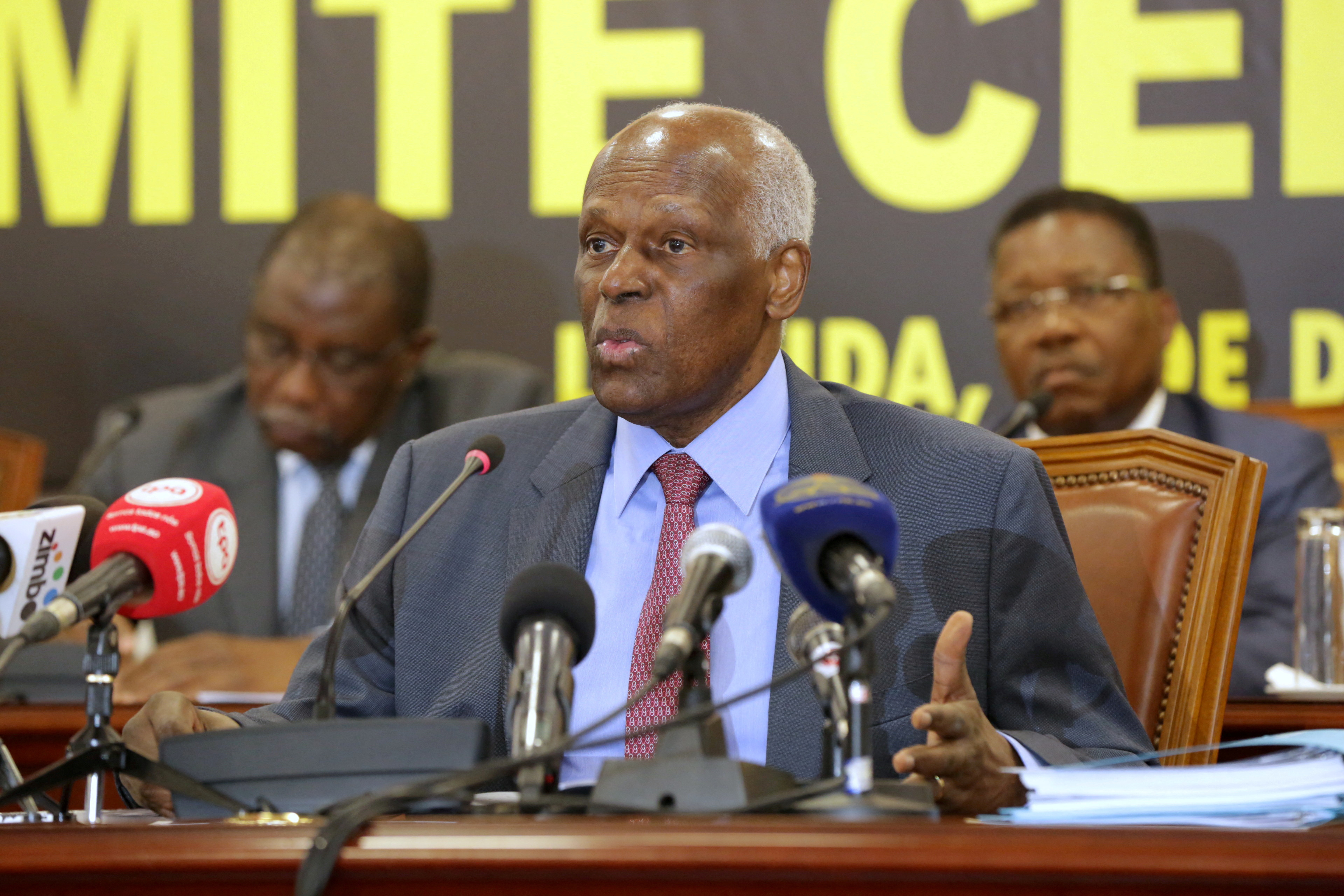Jobs
KCSE Past Papers Chemistry 2014
Published
6 years agoon
[ad_1]
(b) State two uses of radioisotopes in health. (2 marks)
9 The table below shows the relative molecular masses and boiling points of pentane and
ethanoic acid.

Explain the large difference in boiling point between ethanoic acid and pentane. (2 marks)
10 One of the ores of copper has the formula, CuFeS2.
(a) Describe how iron in the ore is removed during extraction of copper metal. (1 mark)
(b) State two environmental problems associated with extraction of copper metal.
(2 marks)
ll Study the flow chart below and answer the questions that follow.
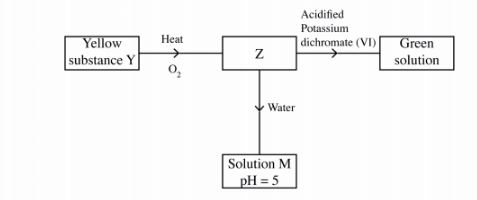
Identify Z and M. (2 marks)
Z …………………………………………………. ..
M …………………………………………………….
12 The table below shows the pH values of solutions A, B, C and D.
Solution

Select solutions in which a sample of lead (ll) hydroxide is likely to dissolve. Give reasons for
each solution selected. (3 marks)
13 100 cm3 of 0.05 M sulphuric (VI) acid were placed in a flask and a small quantity of anhydrous
sodium carbonate added. The mixture was boiled to expel all the carbon (IV) oxide. 25 cmi of
the resulting solution required 18 cm3 of 0.l M sodium hydroxide solution to neutralise
it. Calculate the mass of sodium carbonate added.
(Na : 23.0; O : 16.0; C = 12.0) (3 marks)
14 When 20 cm3 of l M sodium hydroxide was mixed with 20 cm3 of 1 M hydrochloric acid,
the temperature rose by 6.7 “C. Assuming the density of the solution is l g/cm3 and the
specific heat capacity of the solution is 4.2 J g” k”;
(a) calculate the molar heat of neutralisation; (2 marks)
(b) when the experiment was repeated with 1 M ethanoic acid, the temperature change was
found to be lower than that with 1 M hydrochloric acid. Explain. (1 mark)
15 Study the set-up below and answer the questions that follow.
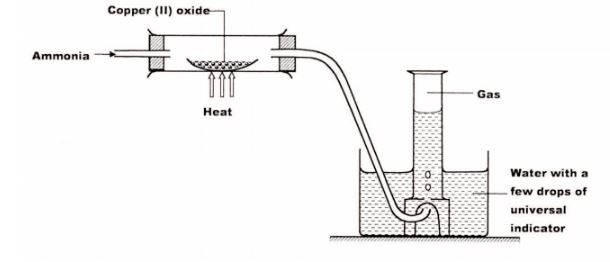
(a) Write an equation for the reaction between ammonia and copper (II) oxide.
(1 mark)
(b) During the experiment, the colour of the contents in the water trough changed.
State the colour change observed and give an explanation. (2 marks)
16 A measuring cylinder fitted with moist steel wool was inverted in a trough of water as shown in
the diagram below.
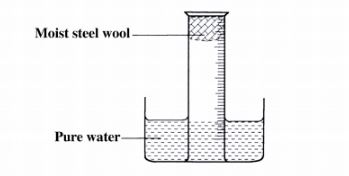
(a) State and explain the observations made on the:
(i) moist steel wool after four days. (1 mark)
(ii) water level in the measuring cylinder after four days. (1 mark)
(b) What would be the effect of using steel wool moistened with salty water? (1 mark)
17 In an experiment on rates of reaction, potassium carbonate was reacted with dilute sulphuric
(VI) acid.
(a) What would be the effect of an increase in the concentration of the acid on the rate of
the reaction? (1 mark)
(b) Explain Why the rate of reaction is found to increase with temperature. (2 marks)
18 Use the part of the periodic table given below to answer the questions that follow.
(Letters are
not the actual symbols of the elements).
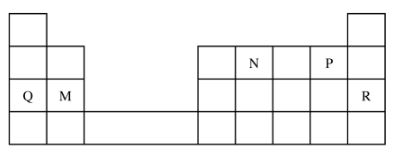
(a) Identify the element that forms giant covalent structures. (1 mark)
(b) Identify one element that does not form compounds. (1 mark)
(c) Write the formula for the nitride of M. (1 mark)
19 Draw a set up that can be used to separate a mixture of sand and iodine. (3 marks)
20 In the contact process, during the production of sulphur (VI) oxide, a catalyst is used.
Give
two reasons why vanadium (V) oxide is preferred to platinum. (2 marks)
21 Given that the atomic number of Y is 13 and that of Z is 9:
(a) write the electronic arrangement of Y and Z; (1 mark)
(b) draw the dot ( .) and cross (X) diagram for the compound fomied by Y and Z.
(1 mark)
22 The set up below was used to separate a mixture of methanol and propanol. Study it and
answer the questions that follow.

(a) State the function of X.(1 mark)
(b) Which liquid will collect first in the beaker? Give a reason.(2 marks)
23 Study the flow chart below and answer the questions that follow.
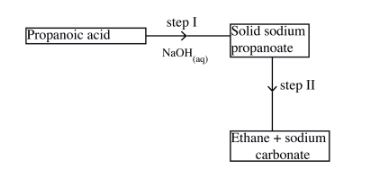
(a) Name the process in step l.(1 mark)
(b) Identify the reagent in step II.(1 mark)
(c) Give one use of ethane.(1 mark)
24 (a) A student electrolysed dilute sodium chloride solution using inert carbon electrodes.
Name the products at:
(i) anode;
(ii) cathode.
(2 marks)
(b) If the experiment was repeated using concentrated sodium chloride instead of dilute
sodium chloride solution, Write the half equation at the anode.
(1 mark)
25 An organic compound had the following composition 37.21% carbon, 7.75% hydrogen and the
rest chlorine. Detemiine the molecular formula of the compound, given that the molecular
mass of the compound is 65. (C : 12.0; H : 1.0; Cl : 35.5). (3 marks)
26 Cotton is a natural polymer. State one advantage and one disadvantage of this polymer.
(2 marks)
Advantage: …………………………………………….. ..
Disadvantage: …………………………………………… ..
27 (a) Name a suitable solvent for extracting an indicator from flowers; (1 mark)
(b) Give a reason Why the solvent named in (a) above is used. (1 mark)
28 A student used the set up below to prepare a sample of nitrogen gas.
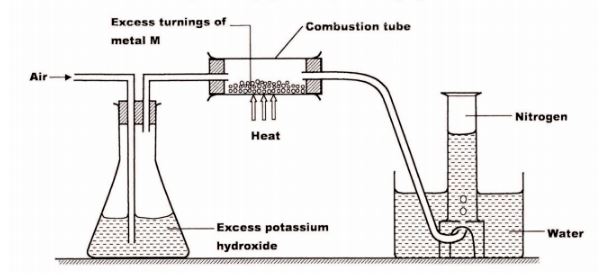
(a) State the function of potassium hydroxide in the set up. (1 mark)
(b) Give a suitable metal M for use in the combustion tube.
(c) Give a reason why the nitrogen gas obtained is not pure. (1 mark)
29 (a) What is meant by the term radical? (1 mark)
(b) The table below contains atoms that form common radicals. Complete the table to
show radicals formed from various atoms.

(2 marks)
30 A gas jar full of chlorine water was inverted over water and allowed to stand for sometime.
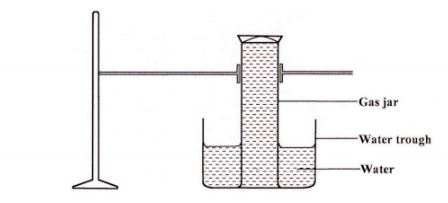
(a) State and explain two observations made in the gas jar after some time. (2 marks)
(b) Write the equation for the reaction between chlorine and hot concentrated potassium
hydroxide. (1 mark)
3.6.2 Chemistry Paper 2 (233/2)
1 (a) The set-up below was used to prepare dry hydrogen chloride gas, and investigate its
effect on heated iron filings.

(i) Name substance L (1 mark)
(ii) Name liquid M. (1 mark)
(m) What will be observed in tube B (1 mark)
(iv) Write an equation for the reaction that occurs in tube B. (1 mark)
(v) Why is the gas from tube B burnt? (1 mark)
(b) (i) Explain the following observations:
(I) a white precipitate is formed when hydrogen chloride gas is passed
through aqueous silver nitrate. (1 mark)
(II) hydrogen chloride gas fumes in ammonia gas. (1 mark)
(ii) State two uses of hydrogen chloride gas. (1 mark)
(c) The diagram below is a representation of an industrial process for the manufacture of a
bleaching powder.

(i) Name substance Q. (1 mark)
(ii) When the bleaching powder is added to water during washing, a lot of soap is
used. Explain. (1 mark)
2 (a) The grid below represents part of the periodic table. Study it and answer the questions
that follow. The letters are not the actual symbols of the elements.

Select the most reactive metal. Explain. (2 marks)
(ii) Select an element that can form an ion with a charge of 3 . (1 mark)
(iii) Select an alkaline earth metal. (1 mark)
(iv) Which group l element has the highest first ionization energy? Explain.
(2 marks)
(v) Element A combines with chlorine to form a chloride of A. State the most
likely pH value of a solution of a chloride of A. Explain. (2 marks)
(b) (i) Explain why molten calcium chloride and magnesium chloride conduct
electricity While carbon tetrachloride and silicon tetrachloride do not.
(2 marks)
(ii) Under the same conditions, gaseous neon was found to diffuse faster than
gaseous fluorine. Explain this observation. (F = 19.0; Ne = 20.0)
(2 marks)
3 (a) Draw the structures of the following:
(i) Butan- l -ol (1 mark)
(ii) Hexanoic acid. (1 mark)
(b) Study the flow chart below and answer the questions that follow.
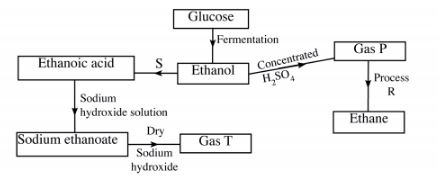
(i) State the conditions necessary for fermentation of glucose to take place.
(1 mark)
(ii) State one reagent that can be used to carry out process S. (1 mark)
(m) Identify gases: (2 marks)
P: ………………………………… ..
T: ………………………………… ..
(iv) How is sodium hydroxide kept dry during the reaction? (1 mark)
(v) Give one commercial use of process R. (1 mark)
(c) When one mole of ethanol is completely burnt in air, l370kj of heat energy is released.
Given that 1 litre of ethanol is 780g, calculate the amount of heat energy released when
l litre of ethanol is completely burnt. (3 marks)
(C = 12.0; H= 1.0; O = 16.0)
(d) State two uses of ethanol other than as an alcoholic drink. (2 marks)
4 (a) Other than temperature, state two factors that determine the rate of a chemical
reaction. (1 mark)
(b) A solution of hydrogen peroxide was allowed to decompose and the oxygen gas given
off collected. After 5 minutes, substance G was added to the solution of hydrogen
peroxide. The total volume of oxygen evolved was plotted against time as shown in the
graph below.

(i) Describe the procedure of determining the rate of the reaction at minute l2.
Explain.
(3 marks)
(ii) How does the production of oxygen in region AB compare with that in region BC?
(2 marks)
(iii) Write an equation to show the decomposition of hydrogen peroxide. (1 mark)
(c) Sulphur (IV) oxide reacts with oxygen to form Sulphur (V1) oxide as shown in the
equation below:
(i) Explain the effect on the yield of SO3 of lowering the temperature for this
reaction .
(2 marks)
(ii) Name one catalyst used for the reaction. (1 mark)
5 (a) The scheme below shows some of the reactions of solution D. Study it and answer the
questions that follow.
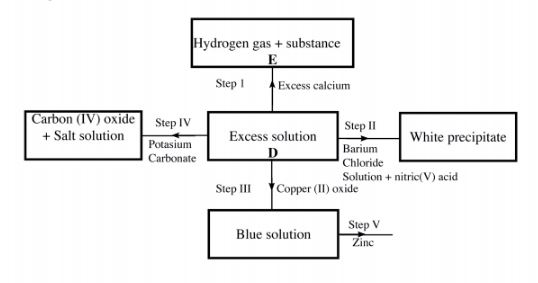
(i) Give a possible cation present in solution D. (1 mark)
(ii) Write an ionic equation for the reaction in Step II. (1 mark)
(iii) What observations would be made in Step V? Give a reason. (2 marks)
(iv) Explain why the total volume of hydrogen gas produced in step 1 was found to
be very low although calcium and solution D were in excess. (2 marks)
(v) State one use of substance E. (1 mark)
(b) Starting with solid sodium chloride, describe how a pure sample of lead (ll) chloride
can be prepared in the laboratory. (3 marks)
(c) (i) State a property of anhydrous calcium chloride which makes it suitable for use
as a drying agent for chlorine gas. (1 mark)
(ii) Name another substance that can be used to dry chlorine gas. (1 mark)
6. The diagram below represents a set up of an electrolyte cell that can be used in the production of aluminium
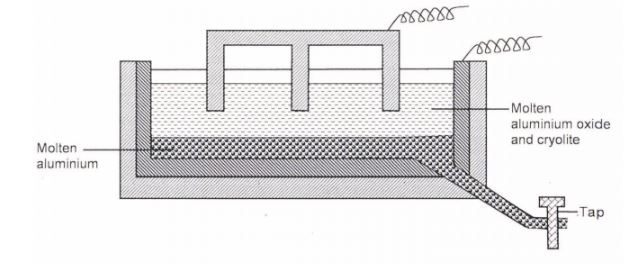
(a) On the diagram, label the anode (1 mark)
(b) Write the equation for the reaction at the anode (1 mark)
(c)Give a reason why the electrolyte process is not carried out below 950°C (1 mark)
(d) Give a reason why the production of aluminium is not carried out using reduction
process (1 mark)
(e) Give two reasons why only the aluminium ions are discharged (2 marks)
(f) State two properties of duralumin that makes it suitable for use in aircraft industry
(g)Name two environmental effects caused by extraction of aluminum (2 marks)
7. (a) Dissolving of potassium nitrate tn water rs an endothermic process Explain the
effect of increase in temperature on the solubility of potassium nitrate
(b) The table below shows the solubility of potassium sulphate and potassium chlorate
(V) at different temperatures.

(i) Draw the solubility curves for both salts on the same axis. (Temperature on the
X-axis). (3 marks)
(ii) A solution of potassium sulphate contains 20g of the salt dissolved in 100g of water at
100°C. This solution is allowed to cool to 25°C.
I At what temperature will crystals first appear? (1 mark)
ll What mass of crystals will be present at 25“C? (1 mark)
(111) Which of the two salts is more soluble at 30°C? (1 mark)
(iv) Determine the concentration of potassium sulphate in moles per litre when the
solubility of the two salts a.re the same (K = 39.0, O = l6.0; S = 32.0). (3 marks)
(v) 100g of water at 100°C contains 19g of potassium sulphate and 19g of potassium
chlorate (V). Describe how a solid sample of potassium sulphate at 60 C can be
obtained. (2 marks)
3.6.3 Chemistry Paper 3 (233/3)
1 You are provided with:
– solution J containing copper (ll) ions.
solution K, 0.1 M sodium thiosulphate.
aqueous potassium iodide, solution L.
solution N, sodium hydroxide.
starch indicator, solution M.
You are required to determine the:
– concentration of copper (ll) ions in solution J;
– enthalpy change of reaction between copper (ll) ions and hydroxide ions.
PROCEDURE 1
(a) Using a pipette and pipette filler, place 25.0 cm-‘ of solution J in a 250 ml volumetric
flask. Add distilled water to make up to the mark. Label this as solution J2. Retain
solution J for use in procedure II.
Place solution K in a burette. Using a clean pipette and pipette filler, place 25.0 cm3 of
solution J2 in a 250 ml conical flask. Add 10 cm3 of potassium iodide, solution L.
Shake well, then add 2 cm3 of starch indicator, solution M. Titrate until a blue-black
colour appears and continue titrating until the blue-black colour just disappears.
Record your readings in Table 1 below.
(c) Repeat step (b) two more times and complete Table 1.
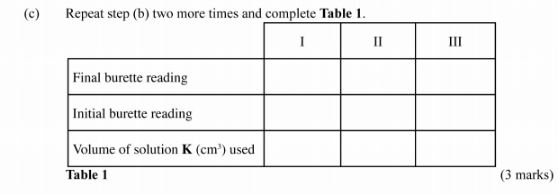
Calculate the;
(i) average volume of solution K used; (1 mark)
(ii) moles of sodium thiosulphate used; (2 marks)
(iii) concentration in moles per litre of copper (ll) ions in solution J given that the number
of moles of copper (ll) ions in 25.0 cm} of solution J2 are the same as the moles of
sodium thiosulphate used. (2 marks)
PROCEDURE 11
(a) Using a clean burette, place 5.0 cm3 of solution N into each of six (6) test-tubes.
(b) Using a 100 ml measuring cylinder, place 20 cm3 of solution J in a 100 ml plastic
beaker. Measure the temperature of solution J and record it in Table 2 below.
(c) To solution J in the beaker, add sodium hydroxide, solution N from one of the test-tubes.
Stir the mixture with the thermometer and record in Table 2, the maximum temperature
reached. Continue with step (d) IMMEDIATELY.
(d)Add the sodium hydroxide, solution N from another test-tube to the mixture obtained
in (c) above, stir and record the maximum temperature reached in Table 2. Continue
adding the sodium hydroxide, solution N from each of the other four test-tubes, stirring
the mixture and recording the maximum temperature each time and complete Table 2.

(i) On the grid provided, plot a graph of temperature (vertical axis) against
volume of sodium hydroxide solution N added. (3 marks)
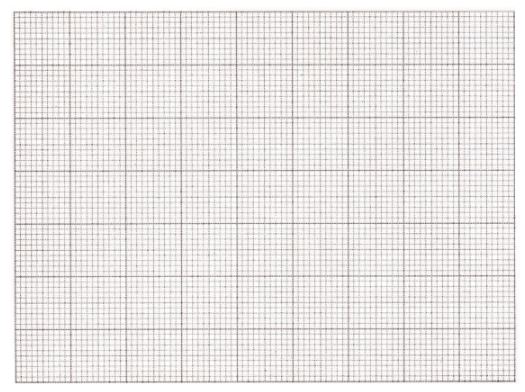
(ii) Using the graph, determine the:
I volume of sodium hydroxide, solution N that reacted completely with
20 cm3 of solution J; (2 marks)
II temperature change, AT, for the reaction; (1 mark)
(iii) enthalpy change of the reaction per mole of copper (ll)ions. (3 marks)
(Heat capacity I 4.2 J g”k”, density of the mixture I 1.0 g cm’3).
2 You are provided With substance P. Can”y out the tests below and Write your observations and
inferences in the spaces provided.
(a) Describe the appearance of substance P. (1 mark)
(b) Place about one-third of substance P in a dry test-tube and heat it strongly.

(c) Place the remaining amount of substance P in a boiling tube. Add about 10 cm3 of
distilled water and shake well. Retain the mixture for tests in (d) below.

(d) Use about 2 cml portions of the mixture obtained in (c) for tests (i) to (iii) below.
(i) Add two to three drops of aqueous barium nitrate to the mixture.

(ii) Add five drop of dilute nitric(V) acid to the mixture

(iii)Add to the mixture aqueous sodium hydroxide dropwise until in excess

(e) Give the formula of the cation and anion present in substance P
Cation:
………… ..
Anion: ………(1 mark)
3 You are provided with an organic substance Q. Carry out the following tests and record
your observations and inferences in the spaces provided.
(a) Place about one-third of substance Q on a metallic spatula and ignite it with a Bunsen
burner flame.

(b) Place the remaining amount of substance Q in a boiling tube and add about 10 cm} of
distilled water. Heat the mixture and allow it to boil for about 30 seconds. Divide the
mixture while still hot into two portions.
(i) To the first portion, add solid sodium hydrogen carbonate provided.

(ii) To the second portion, add two or three drops of acidified potassium manganate

[ad_2]
Source link
Comments
The Kenyan Digest Team

You may like
Rayvanny officially leaves Diamond’s WCB Wasafi after 6 years
Raila Odinga is the most popular presidential candidate, a survey released by Infotrak
Newly-crowned Kenyan Wimbledon champion Angella Okutoyi would like to play against American star Serena Williams

The Mombasa High Court has ordered IEBC to clear Sonko to run for the Mombasa governorship.

A new born baby was pulled out of latrine in Mururi.

Kenyan Rapper Colonel Mustafa has leveled fresh accusations against his ex-girlfriend Katoto.

Okutoyi and Nijkamp qualify for Wimbledon Open final
Fans will have to brace themselves for a sober 90 minutes, the Gulf Arab state announces.
